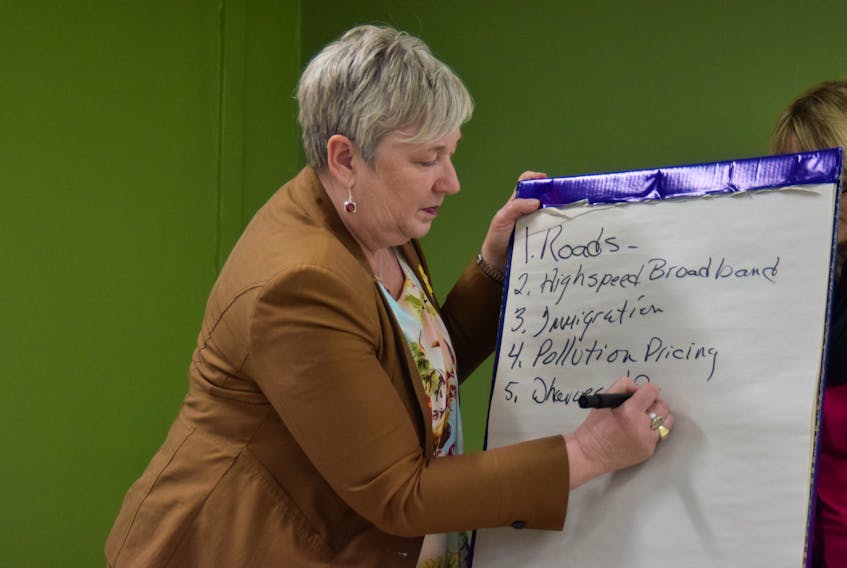BARRINGTON, N.S. — From broadband and immigration. From federal funding for infrastructure projects to small craft harbours. And from carbon tax to EI, there was no shortage of issues up for discussion when South Shore St. Margaret’s MP Minister Bernadette Jordan hosted a town hall meeting at the Barrington Municipal Recreation Centre on Sherose Island on April 15.
Around 20 residents were in attendance to bend Jordan’s ear. It was the 37th town hall she has done in the constituency since taking office in the 2015 election.
“It’s important people know that I’m here to listen,” she said in an interview following the meeting.
During the meeting Jordan fielded numerous questions, clarified issues, and cited examples of how her government is addressing issues. Attendees were mindful this is an election year for the federal government.
HIGH-SPEED INTERNET
Appointed Minister of Rural Economic Development in January, Jordan said one of the main things in her mandate is to bring high-speed internet and cell phone coverage to rural areas.
“We know how important it is. You can’t grow a community if you can’t do business and it’s not just about business,” she said. “It’s about keeping our kids in the community, it’s about doing homework, it’s about attracting doctors. How do you attract professionals to an area if you don’t have broadband? It’s a key part of life.”
Jordan said the federal government allocated $1.7 billion in this year’s budget and plans to leverage that with $4.3 million from other sources for $6 billion to connect rural Canadians. The goal is by 2021, for 90 percent of Canadians to be connected, by 2025 to have 95 percent connected and by 2030 to have 100 percent.
“The last five percent are the most remote areas,” said Jordan, primarily in northern Canada.
Jordan spoke of the success of the Atlantic Immigration Pilot Program, which “was not a platform promise,” but, she said, came from “Atlantic MPs saying we need to do something.”
“We’re in a serious problem here. The average of a fish plant worker in Nova Scotia is 58 years old. The average age of a fish plant worker in New Brunswick is 63. What’s going to happen in 10 years, five years in some cases, so we need to have a labour pool and we don’t have it right now,” she said.
The Atlantic Immigration Pilot Program is employer driven and because of its success in Atlantic Canada has evolved across the country as the Rural Immigration Pilot Program, said Jordan.
“It’s going to take some time. We don’t have a lot of time though. We need to grow our population… We need population growth or immigration. That’s the reality.”
The new federal carbon tax was also discussed, with Jordan setting the record straight that there is no carbon tax system in place in Nova Scotia, like there is in New Brunswick, Ontario, Saskatchewan and Manitoba.
The provinces were given the option of initiating their own program to put a “price on pollution,” she said. In the four provinces that chose not to, a four cents per litre carbon tax has been imposed on the price of fuel by the federal government. Every individual in those provinces will get a rebate, explained Jordan, with 90 percent of the money going back to individuals and the other 10 percent going to municipalities, universities, schools and hospitals and used to reduce emissions by upgrading or installing more energy efficient systems.
“Nova Scotia chose a different way of doing it. We don’t see a direct price at the pump,” said Jordan.
In Nova Scotia, a cap and trade system was initiated as a way to meet carbon emission targets. It has been in place since October.
“Basically, they’re buying and selling carbon credits. The bigger industries that have a lot of emissions will have to buy credits from industries like forestry that produce credits because they are carbon neutral.”
EMPLOYMENT INSURANCE HOURS
Employment Insurance (EI), and how the increase in hours from 520 to 665 needed by seasonal workers in the region to qualify for benefits is creating hardship, was brought to the minister’s attention.
With less work in lobster pounds and on herring processing lines, “people can’t get 665 hours,” said a concerned fish plant worker, who said she works three jobs herself to get enough qualifying hours. In eastern Nova Scotia 420 hours are needed to qualify for EI benefits, and in the Halifax area it is 700.
The hours required for EI benefits are based on the employment rate in area, explained Jordan. Because they are not steadily employed, people keep claims open while they are working, and “it’s seen as people are available to work even though they are already working. There’s a real disconnect there… it throws the system off,” said Jordan, adding she thinks the whole EI system needs an overhaul.
“It’s a huge challenge.”
WHARVES AND HARBOURS
Federal funding for municipal infrastructure projects and small craft harbours were also among the issues discussed. Jordan cited the recent report from the House of Commons Standing Committee on Fisheries and Oceans, Ensuring the Sustainability of the Small Craft Harbours Program, which recommends, among other things, doubling the annual base funding for the small craft harbours program, which hasn’t increased in the past decade.
“There needs to be a long-term solution. We can’t keep putting band-aids on these wharves,” said Jordan, noting since being elected, $30 million has been spent in the riding on small craft harbours projects, primarily in the Shelburne County area.
“We need a long-term plan. Wharves are at capacity, boats are getting bigger,” she said, noting commercial fishing wharves “are our economic drivers” and the driving force of our economy here.
“We need to do something about it,” she said.
Creating a rural economic development strategy is also part of Jordan’s ministerial mandate.
“I will be unveiling the strategy in June and it will probably be a first tier,” she said in the interview. “It’s a huge project. I was only appointed in January so I’ve hit the ground running early trying to find as much information as I can get and as much feedback from as many people as I can, because we realize there’s more to it than one or two things.
“Although we have a huge rural component in the county everyone has the same kind of challenges … we want to make sure that rural communities are sustainable and can continue to grow.”









